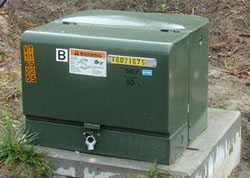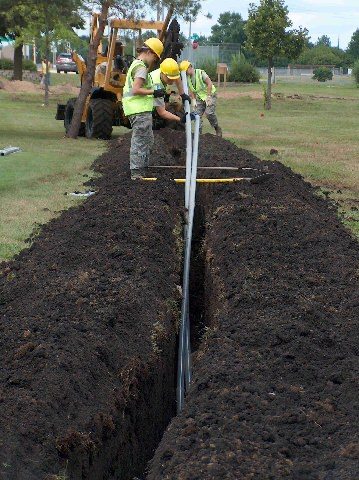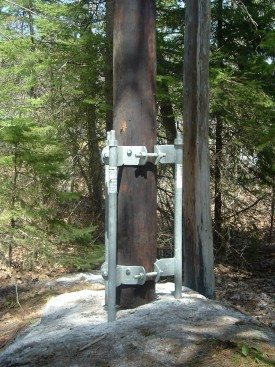One of the more common threads for our customers building a log home is that the location is frequently on raw, undeveloped land, often requiring a significant investment in  infrastructure before the house construction even begins. One element that can involve considerable cost is electric service.
infrastructure before the house construction even begins. One element that can involve considerable cost is electric service.
Each power utility offers guidance for getting power to your log home construction site. Just how much that might be is an important consideration when identifying a parcel of land. Check out the local utility website for construction and access guides.
Measure the route
The first element of cost involves covering the distance from the closest electrical pole or transformer and the home site. While you measure, you’ll need to evaluate the terrain for suitable paths. If the route from the main road/electric line is over any kind of elevated terrain, or land that could potentially hide some underground ledge, the path could be longer so as to avoid challenging land features.
As the measurements are being done, it’s also a good time to consider whether overhead service (on poles) or underground is better suited to your location and budget. If your local area is subject to strong weather, either winter storms or warm-weather hurricanes, underground service may be a more reliable option. The more remote the location, the further down the list for repair and re-electrification should there be a serious disruption. Underground service also can reduce long-term costs, such as tree cutting, and pole replacement.
 If the land is hilly or exhibits a large amount of ledge, poles are probably the only option. Most electrical companies charge per pole, along with associated costs of installation, design, conduit, transformers, mounting pads, and connection to the structure. If the distance from the main road transformer to the building envelope is longer than 1000 feet or so, a transformer will be required to compensate for the drop in voltage caused by the wire’s resistance over a distance.
If the land is hilly or exhibits a large amount of ledge, poles are probably the only option. Most electrical companies charge per pole, along with associated costs of installation, design, conduit, transformers, mounting pads, and connection to the structure. If the distance from the main road transformer to the building envelope is longer than 1000 feet or so, a transformer will be required to compensate for the drop in voltage caused by the wire’s resistance over a distance.
Once the distance is mapped out a cost for electrical infrastructure can be estimated, and added to the total infrastructure costs. If the figure is too high one option might be to relocate the building site closer to the main road. Sometimes the infrastructure costs cannot be justified for a particular parcel and it’s time to explore other properties.
Research Adjacent Properties
When the property is the subject of a partitioning from a larger parcel, electrical service can be impacted by earlier development, especially if the land is accessed from a common private road or driveway. Depending on when the neighbor developed and had electrical service installed, there may be an additional “allotment cost” for a portion of the original electric line installed by the first home. Some utilities charge for a portion of the costs of installation, called an allotment. Others suspend that charge after a time period, say 5 years, has passed from the original installation to the present installation. It’s important to research these possibilities before  putting a property under contract.
putting a property under contract.
Underground Estimates
For underground installations, trenching and PVC conduit piping will be necessary. If you wish to also bring other pole-located services to the new structure — landline telephone, cable, fiber optic— the contractor need to coordinate among the companies to schedule a single date or dates that the installation will be made, as they all need to pull wire through the same conduit and the same trench.
Additionally, should the path of the road and the electrical service cross designated wetlands, perennial streams, or other hazards, the wires will need to be placed in such a way to protect and guard against shorting out. A stream channeled through a culvert is a normal  expense, however, some more extensive construction may be required such as a bridge to carry the electrical service out of danger of the water.
expense, however, some more extensive construction may be required such as a bridge to carry the electrical service out of danger of the water.
Over Ground Expenses
Over ground transmission may also call for some extra expenses beyond the poles, wires, and transformers. If the area is heavily wooded, tree trimming and cutting may be required. This can often be accomplished by a professional tree removal company when clearing the path for the road/driveway and the building site. It may also be less expensive than having the power company do the cutting, and they may also be more aesthetically inclined.
Poles must also have enough dirt in which to be dropped and stabilized. If ledge or other barriers prevent traditional digging, the power company will charge an extra fee for additional bracing and support on ledge surfaces.
Meters
A final line item is the installation of meters to monitor the flow into the house. If the plans include a photovoltaic solar array, a second meter to facilitate net metering will also need to be installed if allowed by the state. Then the utility can act as the storage battery for the solar array when electric demand occurs when there is no sunlight.
